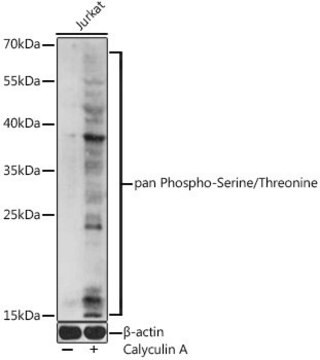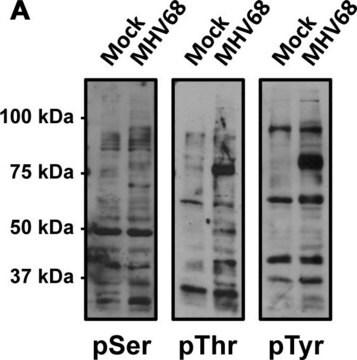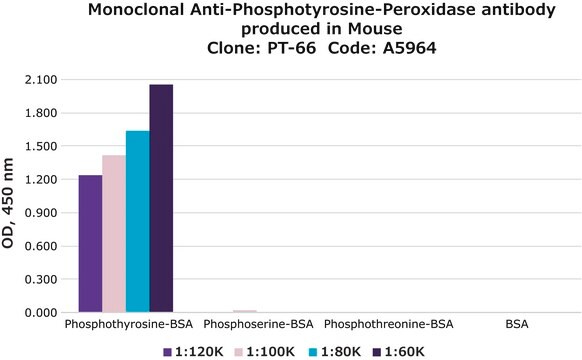推荐产品
生物源
mouse
品質等級
無性繁殖
4A4
4G10® Platinum
製造商/商標名
Upstate®
技術
ELISA: suitable
activity assay: suitable (kinase and phosphatase)
flow cytometry: suitable
immunocytochemistry: suitable
immunofluorescence: suitable
immunohistochemistry: suitable
western blot: suitable
運輸包裝
dry ice
一般說明
4G10 Platinum
The development of the anti-phosphotyrosine, clone 4G10 in 1989 was a monumental discovery for researchers. 4G10 was the first and is the best single monoclonal antibody for the detection tyrosine phosphorylation. 4G10 is well known for its sensitivity and its ability to detect multiple tyrosine phosphorylations on numerous substrates. It has been validated by thousands of scientific and medical researchers in virtually every application and tyrosine target over the past 2 decades. To improve on something that hundred have tried and no one has succeeded, we pooled 4G10 with the next most highly regarded anti-phosphotyrosine, clone PY20 to make 4G10 Platinum. PY20 itself is a very poor substitute for 4G10, but its additive effect allow for a greater level of detection on more substrates that even 4G10 alone was not capable of.
4A4
The identification of protein phosphorylation as a regulatory mechanism originated from studies by Fischer and Krebs in the mid 1950s that later earned them the 1992 Nobel prize. It is the major mechanism for the regulation of diverse cellular processes including cell division, protein synthesis, transcriptional regulation and neurotransmission. The steady state phosphorylation of any given substrate is governed by the opposing activities of kinases and phosphatases. It is now believed that a third of all eukaryotic cellular proteins are phosphorylated and that the majority of all phosphorylation events occur on serine and threonine residues (greater than 95%).
The development of the anti-phosphotyrosine, clone 4G10 in 1989 was a monumental discovery for researchers. 4G10 was the first and is the best single monoclonal antibody for the detection tyrosine phosphorylation. 4G10 is well known for its sensitivity and its ability to detect multiple tyrosine phosphorylations on numerous substrates. It has been validated by thousands of scientific and medical researchers in virtually every application and tyrosine target over the past 2 decades. To improve on something that hundred have tried and no one has succeeded, we pooled 4G10 with the next most highly regarded anti-phosphotyrosine, clone PY20 to make 4G10 Platinum. PY20 itself is a very poor substitute for 4G10, but its additive effect allow for a greater level of detection on more substrates that even 4G10 alone was not capable of.
4A4
The identification of protein phosphorylation as a regulatory mechanism originated from studies by Fischer and Krebs in the mid 1950s that later earned them the 1992 Nobel prize. It is the major mechanism for the regulation of diverse cellular processes including cell division, protein synthesis, transcriptional regulation and neurotransmission. The steady state phosphorylation of any given substrate is governed by the opposing activities of kinases and phosphatases. It is now believed that a third of all eukaryotic cellular proteins are phosphorylated and that the majority of all phosphorylation events occur on serine and threonine residues (greater than 95%).
應用
Research Category
Signaling
Signaling
Research Sub Category
General Post-translation Modification
General Post-translation Modification
This Antibody pack contains Anti-phosphotyrosine Antibody, Anti-Phosphoserine Antibody, validated for use in WB, IF, Flow, IHC, ELISA, ICC.
成分
標靶描述
Dependent upon the molecular weight of the tyrosine phosphorylated protein being detected.
儲存和穩定性
See individual components for storage/handling conditions.
分析報告
Control
Positive Antigen Control: Catalog #12-302, EGF-stimulated A431 cell lysate. Add 2.5µL of 2-mercaptoethanol/100µL of lysate and boil for 5 minutes to reduce the preparation. Load 20µg of reduced lysate per lane for mingels.
Positive Antigen Control: Catalog #12-302, EGF-stimulated A431 cell lysate. Add 2.5µL of 2-mercaptoethanol/100µL of lysate and boil for 5 minutes to reduce the preparation. Load 20µg of reduced lysate per lane for mingels.
法律資訊
UPSTATE is a registered trademark of Merck KGaA, Darmstadt, Germany
免責聲明
Unless otherwise stated in our catalog or other company documentation accompanying the product(s), our products are intended for research use only and are not to be used for any other purpose, which includes but is not limited to, unauthorized commercial uses, in vitro diagnostic uses, ex vivo or in vivo therapeutic uses or any type of consumption or application to humans or animals.
儲存類別代碼
10 - Combustible liquids
我们的科学家团队拥有各种研究领域经验,包括生命科学、材料科学、化学合成、色谱、分析及许多其他领域.
联系技术服务部门








